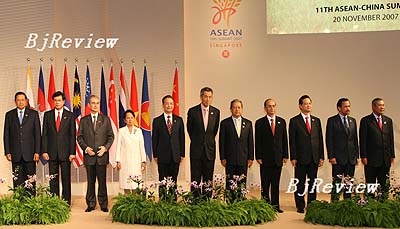|

China has been a trustworthy supporter and partner for Southeast Asian countries. Premier Wen Jiabao enhanced this positive image in Singapore last November when he addressed a series of multilateral summits held within the framework of the Association of Southeast Asian Nations (ASEAN).
Wen not only reaffirmed China's support for ASEAN's integration process, but also underscored China's eagerness to build "a peaceful, harmonious and prosperous Asia" together with ASEAN and other countries in the ASEAN Plus Three mechanism.
This mechanism, which involves ASEAN, China, Japan and South Korea, was established 10 years ago. Initially it focused on economic cooperation, but it has expanded in recent years to cover sectors such as politics, security and culture.
"The ASEAN Plus Three mechanism has set a good example for regional cooperation in Asia," Wen said at the ASEAN Plus Three Summit.
Foreign affairs experts agreed that ASEAN will play an important role in East Asian cooperation despite its loose organization. At the same time, they hailed the steady progress in China-ASEAN relations.
China and ASEAN have become each other's fourth largest trading partner, with their two-way trade volume growing an average of about 20 percent annually since 1991. In November 2002, the two sides signed an agreement in Phnom Penh, Cambodia, to establish a free trade area by 2010. When completed, the China-ASEAN Free Trade Area will be the world's most populous free trade area, the largest trading bloc of developing countries and the most promising free trade area around the globe.
Xu Ningning, Deputy Secretary General of the China-ASEAN Business Council, said great strides have been made each year since the free trade agreement was signed. The average tariff level has been reduced to 5.8 percent from 9.9 percent in 2005. Tariffs on more than 5,300 commodities have been reduced or exempted.
China and ASEAN also have started to open the services market, Xu said. The first group of service sectors, including construction, transportation, tourism and business services, was opened in July. Negotiations are currently underway on plans for next year. China and ASEAN also are negotiating an investment agreement for their free trade area.
With these steps, China-ASEAN trade soared in recent years, hitting more than $146 billion from January to September this year, up 26 percent from the same period last year. The number is expected to exceed $200 billion next year, reaching the preset goal two years ahead of time, Xu said.
Driving force
Four decades after its founding, ASEAN became a legal entity with the adoption of a charter in Singapore. The charter also defines the organization's strategic objectives, principles, status and structure. It introduces a number of structural changes, such as convening the ASEAN Summit twice a year instead of once a year, having ASEAN foreign ministers serve as members of the ASEAN Coordinating Council, appointing member states' permanent representatives to form a Committee of Permanent Representatives in Jakarta and establishing an ASEAN human rights body.
At the same time, the charter designates an ASEAN motto, flag, emblem, an ASEAN day on August 8 and English as ASEAN's working language.
In a joint statement issued at the ASEAN Plus Three Summit in Singapore, leaders reaffirmed a long-term goal of building an East Asian community with the ASEAN Plus Three mechanism as "the main vehicle" and ASEAN as "a driving force."
Although ASEAN is not as powerful as China, Japan or India, it plays a distinctive role in East Asian cooperation, because it brings countries in the region together and provides a stage for different players, said Zhai Kun, an expert on Southeast Asian studies at the China Institutes of Contemporary International Relations. The charter will make ASEAN more institutionalized to a certain extent, he said. But no comparison should be made between ASEAN and the EU. Southeast Asia is so diversified that it is extremely difficult for the various countries to abide by common rules as do EU countries, he said.
ASEAN was meant to be a "loose organization" when it was conceived, Zhai said. This has helped the organization to maintain its vigor and vitality for the past 40 years. ASEAN makes sense mainly because its member countries can pursue their own goals while having a common goal to coordinate their efforts, he said. The charter was adopted to address and cope with new challenges posed by globalization, the rise of China and India and ASEAN's internal affairs. Although ASEAN considers it a landmark, the charter is more of a symbolic document, he said.
Su Jingxiang, Deputy Director of the Institute of International Studies at Tsinghua University, said challenges remain for deepening East Asian cooperation and building a "harmonious" East Asia. These include political instability, territorial disputes, international energy and resource price hikes, financial risks and threats posed by national separatism, international terrorism and religious extremism, and ecological and environmental hazards.
In light of the new opportunities and challenges, Wen put forward at the ASEAN Plus Three Summit a five-point proposal on strengthening and deepening ASEAN plus Three cooperation. He suggested exploring and developing models and ways of cooperation that are compatible with the diversity of East Asia. Cooperative mechanisms such as ASEAN Plus Three, ASEAN Plus One, the East Asia Summit and the ASEAN Regional Forum all have distinctive rules and priorities, but they share some common features, such as respecting diversity, using a step-by-step approach to fostering cooperation, seeking common ground while shelving differences, being dynamic in diversity and pursuing common benefits, he said.
| 